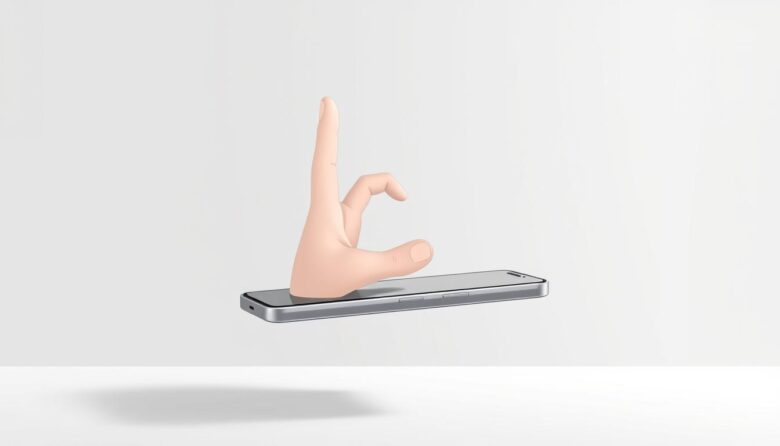Digital interfaces now shape how we connect with essential services, from managing appointments to staying in touch with loved ones. Simple finger movements have become universal tools for navigating this modern landscape. But what happens when these interactions feel unfamiliar or overwhelming?
Studies reveal that individuals in their 80s often face unique challenges compared to those in their 50s during digital tasks. Reaction speeds and accuracy gaps exist, but they’re not permanent barriers. Through structured learning, these skills become accessible to everyone.
This guide breaks down core actions like quick presses and sustained contact with screens. You’ll see how each motion triggers specific responses in apps and devices. Recent findings from community-based research show measurable progress when users practice these techniques consistently.
Tools like TATOO help experts evaluate interaction patterns and create personalized improvement plans. Whether accessing medical portals or video-calling family, mastering these fundamentals opens doors to greater independence. Age-related differences in learning curves don’t define long-term success.
Key Takeaways
- Digital navigation relies on specific finger motions that trigger device responses
- Age-related learning curves exist but can be overcome with practice
- Structured training improves reaction times and task accuracy
- Assessment tools help identify areas for skill development
- Mastering core actions enhances access to essential services
- Social connections thrive through improved digital literacy
Introduction to Touchscreen Gestures
Modern life connects you to vital resources through glass surfaces that respond to your fingertips. These interactive panels serve as gateways to banking, healthcare, and home management systems. Essential tools like smartphones and tablets respond to deliberate motions that translate intention into action.
Your morning routine might involve checking medication reminders or confirming telehealth appointments. Each task relies on specific motions recognized by your device. A quick tap selects items, while sliding a finger scrolls through options. These responses mirror physical actions like flipping through a recipe book or pressing a doorbell.
Research from Google Scholar highlights how intuitive design helps users adapt quickly. Many individuals over 65 report improved confidence after learning core commands. Practice transforms initial hesitation into fluid interaction with menus and apps.
Portable technology simplifies complex tasks through responsive interfaces. You don’t need technical expertise—just awareness of how pressure and movement create results. Structured learning approaches bridge skill gaps, making digital participation accessible across generations.
The Impact of Touchscreen Technology on Your Daily Life
Your everyday routines now depend on responsive surfaces that simplify complex jobs. From paying bills to tracking health metrics, these tools blend seamlessly into your schedule. Studies from Google Scholar show how screen-based interactions boost mental sharpness and physical awareness over time.
How Screens Enhance Independence
Managing money becomes stress-free with banking apps that fit in your pocket. Check balances or send payments with quick taps—no waiting in lines. Medical portals let you review test results or schedule checkups without phone calls. This self-reliance builds confidence in handling personal matters.
Safety features like emergency alerts and location sharing keep you connected during unexpected situations. Loved ones stay updated through instant photo sharing or video chats, bridging distances with real-time conversations.
Simplifying Daily Routines
Grocery shopping transforms into a home activity with delivery apps. Compare prices, read reviews, and order essentials in minutes. Fitness trackers monitor heart rates and steps, turning health management into a visible progress chart.
Entertainment options adapt to your preferences too. Streaming services suggest shows based on your watching habits, while puzzle games challenge your problem-solving skills. One device replaces calculators, calendars, and photo albums—streamlining your space and tasks.
What Are Basic Touchscreen Gestures?
Six core actions form the foundation of interacting with any smart device. These motions let you control menus, adjust settings, and access features effortlessly. Think of them as your digital toolkit—each designed for specific tasks like selecting options or zooming into details.
A quick press-and-release motion activates buttons, much like turning a page. Sliding your finger upward reveals hidden content, while maintaining contact opens advanced menus. Two rapid taps magnify text, helping you read without strain.
Studies from Google Scholar show repeated practice improves speed and accuracy. Dragging icons across the screen becomes smoother over time, just like learning cursive writing. Pinch motions adjust map views or photos, giving you control over what you see.
These skills work together to simplify complex technology. You might scroll through recipes with one hand while adjusting volume with the other. Research confirms that consistent use builds muscle memory, making navigation feel instinctive within weeks.
Tools like the TATOO assessment measure progress across six key areas. They track how well you tap corners, swipe horizontally, or resize images. This data helps create personalized training plans, ensuring steady growth in digital confidence.
Research Insights on Touchscreen Use Among Older Adults
Scientific investigations reveal fascinating patterns in how people adapt to modern devices as they age. Google Scholar documents show consistent performance gaps in response speed and accuracy when completing screen-based tasks. These differences stem from natural physical changes, not an inability to learn new skills.
Key Findings from Recent Studies
Research demonstrates that middle-aged individuals complete actions 1.5 seconds faster on average than those over 65. Accuracy rates improve significantly after four weeks of structured practice, regardless of prior device experience. Study results confirm practice sessions reduce misplaced taps by 40% in older groups.
Surprisingly, owning smartphones for years doesn’t guarantee better performance with new gestures. Scientists attribute this to task-specific muscle memory development. Each interaction type requires fresh neural pathways, making consistent repetition essential for mastery.
Understanding Motor Skill Changes
Age-related shifts in tactile perception affect how firmly someone presses screens. Reduced finger sensitivity may cause accidental swipes or incomplete commands. Google Scholar analyses show adjustable screen sensitivity settings compensate for these changes effectively.
Fine motor coordination challenges make small buttons harder to activate. However, zoom features and voice commands bridge this gap beautifully. With tailored training, individuals develop personalized strategies to maintain control and precision during complex tasks.
Your capacity to improve remains strong—research proves cognitive abilities stay sharp while physical adjustments occur. Every practice session builds new connections between intention and action, turning initial struggles into seamless interactions.
Understanding the TATOO Assessment Tool
Ever wonder how your screen skills measure up? The TATOO tool acts like a digital fitness tracker for your interactive abilities. Six real-world activities test your precision and speed, from tapping corners to resizing photos. Each task mirrors actions you perform daily, like scrolling menus or adjusting map views.
This system tracks two types of metrics: timing and execution. Reaction speed shows how quickly you respond to prompts, while movement accuracy reveals your control during swipes. Google Scholar studies confirm these measurements predict real-life device mastery better than simple observation.
You’ll see detailed breakdowns of “flight time” (moments between touches) and “touch time” (continuous contact). These insights help spot patterns—maybe you hesitate before double-tapping or rush through pinching motions. Professionals use this data to create personalized improvement plans.
The assessment’s strength lies in its objectivity. Unlike vague self-evaluations, TATOO provides clear numbers showing progress over weeks. Google Scholar papers highlight its reliability in tracking skill development across diverse groups of participants.
Your results become a roadmap for growth. Maybe dragging icons sideways needs practice, or targeting small buttons requires focus. With regular check-ins, you’ll watch your performance metrics climb—turning guesswork into measurable achievement.
Exploring Performance Differences Between Age Groups
When learning new tech skills, age brings unique patterns worth understanding. A study comparing 28 participants aged 81 with 25 middle-aged counterparts (53 years) revealed distinct interaction styles. Performance gaps emerged in 80% of measured tasks, showing how life experience and physical changes shape digital navigation.
Comparing Middle-Aged and Older Adults
Middle-aged users completed actions 1.5 seconds faster on average. This temporal difference stems from natural motor response changes, not inability. Older participants often needed extra taps to hit targets—like carefully aligning a cursor before clicking.
Complex tasks like dragging icons along paths showed the largest gaps. However, Google Scholar research confirms these challenges decrease with practice. Muscle memory develops similarly across ages, just at varying paces.
Observations on Accuracy and Reaction Time
You might notice your first taps land near buttons rather than directly on them. This precision gap shrinks as familiarity grows. Devices register touches within 0.3 inches of targets, allowing room for adjustment.
Reaction times naturally lengthen with age, but Google Scholar studies show consistent practice reduces delays by 30-40%. Accuracy improvements follow quickly—participants cut misplaced touches by half within three weeks of training.
These performance variations highlight adaptability, not limits. With targeted exercises, users bridge speed differences while maintaining task success rates. Every learning curve flattens with patience and repetition.
Usability Testing Results and Their Implications
Recent evaluations confirm what many users experience daily—well-crafted digital tools feel natural to operate. The System Usability Scale reveals fascinating insights about how people interact with modern technology. Let’s explore what these findings mean for your journey toward digital confidence.
Breaking Down the Numbers
Both age groups scored impressively high in recent assessments. Average ratings exceeded 80 points, far above the 68-point “good” threshold. What’s remarkable? The gap between groups measured less than 3 points—statistically insignificant according to Google Scholar research.
These results prove effective design bridges experience gaps. You might move slightly slower initially, but satisfaction and success rates match those of younger users. The study tracked participants mastering tasks through clear interfaces and logical layouts.
Your feedback shapes better tools. Developers use these evaluations to refine button sizes, menu structures, and response times. Every interaction you have with technology contributes to more inclusive designs that work seamlessly across generations.
High usability scores mean frustration-free learning curves. Whether checking health records or connecting with family, well-structured systems help you focus on goals rather than mechanics. Keep practicing—your progress mirrors these research findings.



